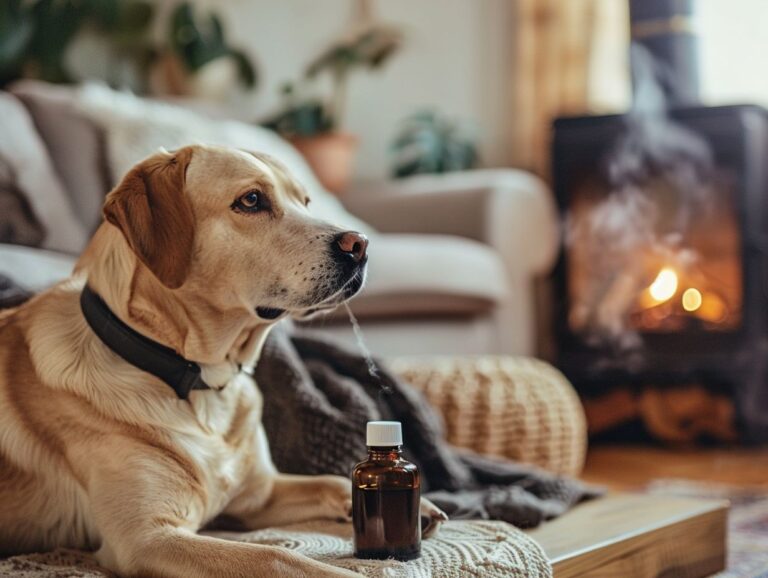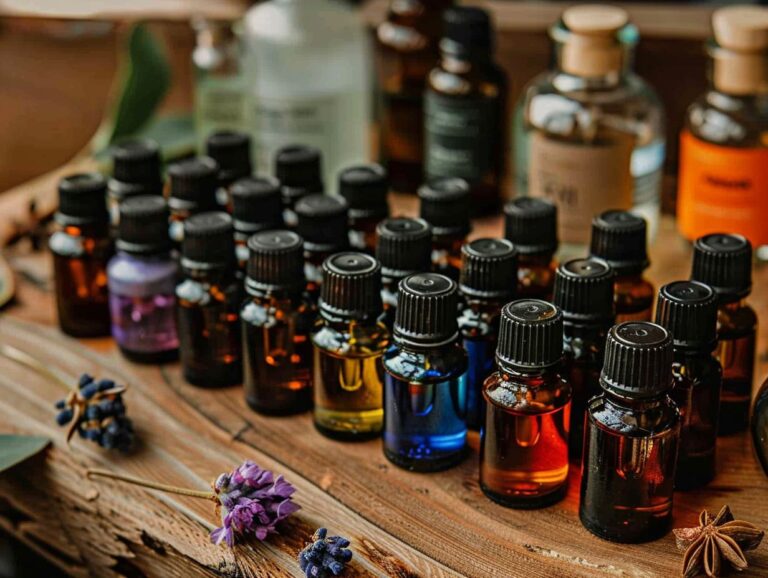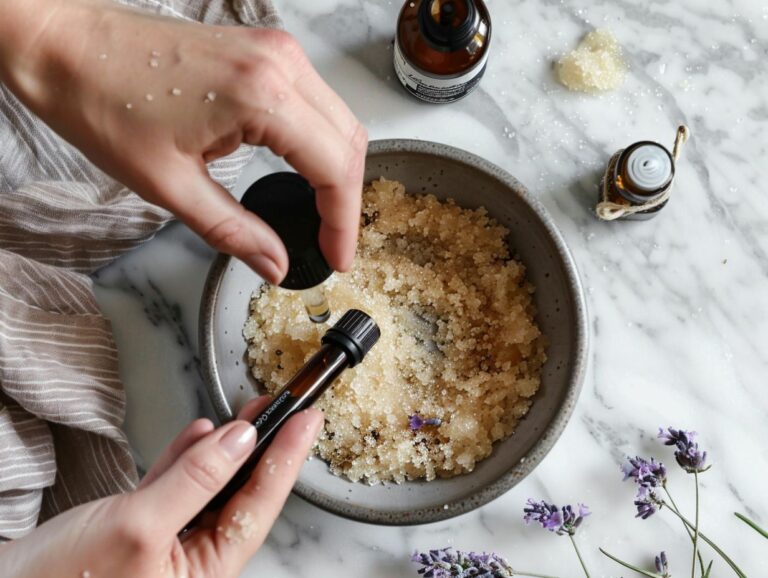What Essential Oils to Use in Diffuser
Essential oils have been used for centuries for their therapeutic benefits. Have you ever wondered how they work in a diffuser?
We will explore the different types of essential oils that can be used in a diffuser, such as citrus, floral, herbal, and woody oils.
Discover the numerous benefits of using essential oils in a diffuser, including promoting relaxation, improving sleep quality, boosting mood and energy, and purifying the air.
We will provide safety precautions to keep in mind when using essential oils in a diffuser, such as diluting oils properly and avoiding certain oils for children and pets.
Join us as we dive into the world of essential oils and learn how they can enhance your well-being.
Key Takeaways:
What Are Essential Oils?
Essential oils are highly concentrated plant extracts that capture the aromatic and therapeutic properties of plants, such as Lavender oil and Peppermint oil. These oils are commonly used in aromatherapy to promote physical and emotional well-being.
The origins of essential oils date back centuries, with their use rooted in ancient civilizations like Egypt, Greece, and China. These oils are extracted through various methods, including steam distillation, cold pressing, and solvent extraction.
Can you use Bath and Body Works essential oils in a diffuser? Lavender oil, known for its calming properties, is often used to reduce stress and improve sleep quality. Peppermint oil, on the other hand, is invigorating and can help alleviate headaches and boost energy levels.
Aromatherapy, when integrated into skincare routines, can help improve skin conditions and reduce inflammation. The use of essential oils in relaxation practices can aid in reducing anxiety and promoting overall mental wellness.
How Do Essential Oils Work in a Diffuser?
Essential oils work in a diffuser by being dispersed into the air in a fine mist or vapor, allowing their therapeutic scents and properties to be inhaled and absorbed. This diffusion process is known as diffusing, which helps to disperse the oils throughout a room effectively.
The diffusing of essential oils in a diffuser is a fascinating process that not only fills the air with delightful fragrances but also imparts numerous benefits. The diffuser, through its various mechanisms, breaks down the essential oils into tiny molecules that then disperse evenly in the surrounding air. Essential oils, known for their aromatic and medicinal properties, can uplift mood, promote relaxation, boost focus, and even purify the air. Different types of diffusers like ultrasonic, nebulizing, heat, and evaporative diffusers impact how the oils diffuse, affecting the potency and longevity of the scent in the room.
What Are the Benefits of Using Essential Oils in a Diffuser?
Using essential oils in a diffuser offers numerous benefits such as promoting relaxation, reducing stress levels, improving mood and energy, and providing a soothing atmosphere. The calming properties of oils like Lavender and the invigorating effects of Peppermint contribute to these positive outcomes.
Diffusing essential oils can have a profound impact on one’s well-being. For instance, the gentle scent of Lavender oil is renowned for its ability to calm the mind and body, making it ideal for unwinding after a long day or promoting a good night’s sleep.
On the other hand, the refreshing aroma of Peppermint oil can provide an instant energy boost, enhance focus, and alleviate headaches. By simply adding a few drops of these oils into a diffuser, you can transform your living space into a sanctuary of relaxation and positivity.
Promotes Relaxation and Reduces Stress
One of the key benefits of using essential oils in a diffuser is their ability to promote relaxation and reduce stress. Oils like Lavender oil are known for their calming effects, making them ideal for creating a tranquil environment.
What sets Lavender oil apart is its unique composition, containing compounds like linalool and linalyl acetate. These components interact with the olfactory system when inhaled, sending signals to the brain’s limbic system, which controls emotions and memories.
This process triggers the release of neurotransmitters like serotonin and dopamine, promoting feelings of relaxation and calmness. The scent of Lavender has been shown to lower cortisol levels, a stress hormone, leading to a reduction in anxiety and improved sleep quality.
Improves Sleep Quality
Essential oils in a diffuser can help improve sleep quality by creating a calming atmosphere conducive to rest. Custom diffuser blends can be crafted using oils like Lavender and Clary Sage to promote relaxation and enhance the sleep experience.
These two oils, Lavender and Clary Sage, are well-known for their soothing properties.
Lavender, with its gentle floral scent, is widely recognized for its calming effects that can alleviate anxiety and induce a sense of tranquility.
On the other hand, Clary Sage, with its earthy and slightly fruity aroma, is often used to reduce stress and promote a deeper, more restful sleep.
When combined in a diffuser blend, these oils create a powerful synergy that can significantly improve sleep quality, helping you unwind and drift off into a peaceful slumber.
Boosts Mood and Energy

The invigorating scent of Peppermint essential oil is known to have a cooling effect that can instantly awaken the senses and promote mental clarity, making it an excellent choice for when you need a pick-me-up during a busy day.
Diffusing Peppermint oil can create a vibrant and stimulating environment, perfect for home offices or study areas where concentration and focus are essential. Its crisp, minty fragrance can also help alleviate feelings of stress and promote a sense of alertness.
Purifies Air and Kills Germs
Essential oils used in a diffuser not only create a pleasant scent but also help in purifying the air and eliminating germs. Frankincense oil, with its antimicrobial properties, is effective in cleansing the air and promoting a healthier environment.
When diffused, Frankincense oil acts as a natural air purifier, killing airborne pathogens and bacteria. This oil does not just mask odors; it actually neutralizes the root cause by destroying harmful microbes. By incorporating oils like Frankincense into your daily routine, you not only infuse your space with delightful aromas but also ensure that your surroundings are free from harmful germs, providing a sanctuary of cleanliness and freshness.
What Are the Different Types of Essential Oils?
Essential oils come in various types, including Citrus oils, Floral oils, Herbal oils, and Woody oils. Each type offers unique scents and therapeutic properties for a diverse range of aromatherapy blends.
Citrus oils, such as lemon and orange, are known for their uplifting and energizing qualities, perfect for enhancing mood and boosting focus.
Floral oils, like lavender and rose, are widely used for relaxation and stress relief due to their calming effects.
Herbal oils, such as peppermint and eucalyptus, are popular for their refreshing and invigorating properties, ideal for respiratory support. Learn more about roll-on essential oils in diffuser.
Woody oils, including cedarwood and sandalwood, are grounding and comforting, often used in meditation practices to promote feelings of stability and balance.
Citrus Oils
Citrus oils are known for their uplifting aroma and refreshing qualities, making them popular choices for boosting mood and energy. Ylang Ylang oil, often found in citrus blends, adds a sweet floral note to the overall scent.
These oils, such as lemon, orange, and grapefruit, are not only celebrated for their invigorating fragrance but also for their mood-enhancing properties. The zesty and citrusy notes have a remarkable ability to uplift and revitalize the senses, promoting a sense of positivity and vitality.
When combined with the lush and floral fragrance of Ylang Ylang oil, the citrus blends reach a harmonious balance. The inclusion of Ylang Ylang enhances the overall aroma, bringing a depth and complexity while maintaining the energizing essence of the citrus oils.
Floral Oils
Floral oils offer delicate and soothing aromas that promote relaxation and calmness. Rosemary oil, commonly used in floral blends, adds a herbaceous note that complements the floral scents for a harmonious blend.
These oils are cherished for their ability to induce a sense of tranquility and peace, perfect for creating a serene atmosphere. The gentle floral notes of oils like Lavender, Jasmine, and Ylang-Ylang can transport you to a peaceful garden, while the addition of Rosemary oil infuses a subtle freshness and grounding element.
Herbal Oils
Herbal oils possess earthy and therapeutic properties that support overall health and well-being. Frankincense oil, a key herbal oil, is renowned for its anti-inflammatory and soothing effects on the body and mind.
Regarding physical health, Frankincense oil can be used topically to alleviate muscle aches and joint pain, thanks to its analgesic properties. Its calming aroma makes it a popular choice for aromatherapy to reduce stress and anxiety, promoting mental well-being.
Frankincense oil is often blended with other herbal oils like lavender and peppermint to create synergistic blends that enhance the overall therapeutic benefits. These blends can be used in massages, diffusers, or even added to skincare products for a holistic approach to health and wellness.
Woody Oils

Woody oils emanate grounding and calming aromas that help stabilize mood and emotions.
Clary Sage oil, a popular woody oil, is often used in blends to enhance the calming properties. Its subtle earthy fragrance blends seamlessly with other woody notes, such as Cedarwood and Sandalwood, creating a multi-dimensional scent profile that promotes a sense of tranquility. Is using essential oils in a diffuser safe?
When diffused, these woody essential oils can uplift spirits and promote mental clarity, making them ideal for meditation practices or winding down after a long day. The combined effects of these oils help induce a peaceful and harmonizing ambiance in any space.
How to Choose the Right Essential Oils for Your Diffuser?
Selecting the right essential oils for your diffuser involves considering your preferences, desired effects, and specific aromatherapy goals. Exploring various diffuser blends and recipes can help create customized scent combinations tailored to your needs.
When choosing essential oils, it’s important to focus on the scents that resonate with you personally. For instance, if you enjoy floral fragrances, opt for oils like lavender or rose that can promote relaxation and calmness. On the other hand, if you prefer citrusy scents, consider oils such as lemon or grapefruit for a refreshing and invigorating atmosphere.
What Are the Safety Precautions When Using Essential Oils in a Diffuser?
When using essential oils in a diffuser, it is essential to observe safety precautions to prevent skin sensitivities or adverse reactions. Ensuring the quality of oils and consulting with a dermatology expert like Mr. Kakar can help in safe and effective usage.
Quality essential oils play a crucial role in ensuring a positive experience when using a diffuser. Contaminated or low-grade oils can lead to skin irritation and other undesirable effects. Before diffusing any oil, it’s advisable to conduct a patch test on a small area of skin to check for any adverse reactions.
Consulting with a professional, like a certified aromatherapist or a dermatologist, can provide personalized guidance on which oils are safe for individual skin types and conditions.
Dilute Essential Oils Properly
Properly diluting essential oils before diffusing is crucial to prevent skin irritation and ensure the oils are used safely.
When essential oils are applied directly to the skin without proper dilution, they can lead to adverse reactions such as redness, itching, or even burns. Diluting essential oils with carrier oils such as jojoba, coconut, or almond oil helps to reduce the risk of skin sensitivity and promotes better absorption.
Incorporating carrier oils or skincare products not only reduces the intensity of the essential oil’s potency but also aids in delivering the oil’s benefits effectively to the skin. Maintaining the proper dilution ratio is key to maximizing the therapeutic properties of essential oils while minimizing potential side effects.
Use a High-Quality Diffuser
Using a high-quality diffuser is essential for effective and safe dispersal of essential oils in the air. A reliable diffuser enhances the benefits of aromatherapy and ensures proper diffusion of the oils’ therapeutic properties.
When looking for the perfect diffuser, consider the capacity of the water tank to determine how long it will run before needing a refill. Opt for a diffuser with different timer settings, allowing you to customize the duration of diffusion based on your needs. Another important feature is the type of diffusion method the diffuser uses, whether it’s ultrasonic, nebulizing, or heat-based, each with unique benefits. Also, pay attention to the coverage area to ensure it can efficiently fill your desired space with the aroma of essential oils.
Avoid Certain Oils for Children and Pets
Some essential oils can be harmful to children and pets due to their potency and composition. It is crucial to avoid oils that may pose risks to the well-being of children and pets, ensuring a safe and healthy environment.
Common essential oils that are unsafe for children and pets include tea tree oil, eucalyptus oil, peppermint oil, and wintergreen oil. These oils contain compounds that can be toxic to young children and pets if ingested or inhaled in large quantities. When diffused, these oils can cause respiratory issues or skin irritations for sensitive individuals,
Instead, opt for safe alternatives such as lavender oil, chamomile oil, or frankincense oil. These oils are gentle, soothing, and have calming properties that are safe for use around children and pets. Consider using a diffuser with these oils to create a relaxing and pet-friendly atmosphere in your home.
Be Aware of Potential Allergies

Allergies to essential oils can manifest in various ways, from skin irritation to respiratory issues. To test for sensitivities, it is recommended to conduct a patch test before using a new oil extensively. Observing any redness, itching, or inflammation can indicate a potential allergy. Individuals with asthma or other respiratory conditions should be cautious when using strong-smelling oils, as they may trigger breathing difficulties. Consulting with a healthcare professional or aromatherapist can provide valuable guidance on selecting oils that suit specific health concerns and preferences. Researching the properties of oils and their potential interactions with medications ensures a safe and enjoyable experience.”
Frequently Asked Questions
What Essential Oils Should I Use in My Diffuser?
There are a variety of essential oils that can be used in a diffuser, depending on your specific needs. Some popular options include lavender for relaxation, peppermint for energy and focus, and eucalyptus for respiratory support.
Can I Mix Essential Oils in My Diffuser?
Yes, you can mix essential oils in your diffuser to create a customized blend. However, it’s important to research the properties and potential interactions of each oil before combining them. Start with a small amount of each oil and adjust as needed.
How Many Drops of Essential Oil Should I Use in My Diffuser?
The number of drops of essential oil to use in your diffuser will vary depending on the size and type of diffuser. As a general guideline, 3-5 drops per 100 ml of water is a good starting point. Adjust based on your personal preference and the strength of the oil.
Which Essential Oils Should I Avoid Using in My Diffuser?
Some essential oils, like cinnamon and clove, can be irritating when diffused and should be used with caution. It’s also important to avoid using essential oils that you are allergic or sensitive to. Always do a patch test before diffusing a new oil.
Do I Need to Use Carrier Oils in My Diffuser?
No, you do not need to use carrier oils in your diffuser. Carrier oils are typically used for topical application of essential oils, but they are not necessary for diffusing. However, if you have a particularly sensitive nose, you can dilute the essential oils with a carrier oil before adding them to your diffuser.
Can I Diffuse Essential Oils Around Children and Pets?
It’s important to research and use caution when diffusing essential oils around children and pets. Some oils, such as peppermint and eucalyptus, can be too strong for young children and animals. Always dilute oils and use in a well-ventilated area when around children and pets.








One Comment